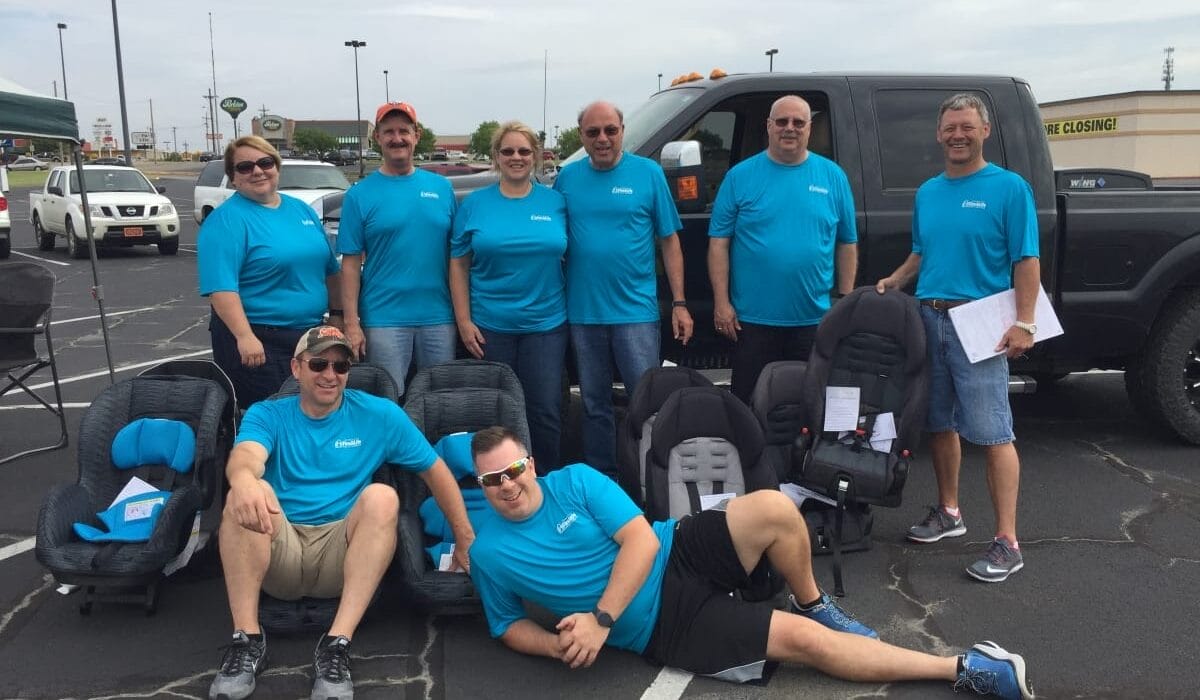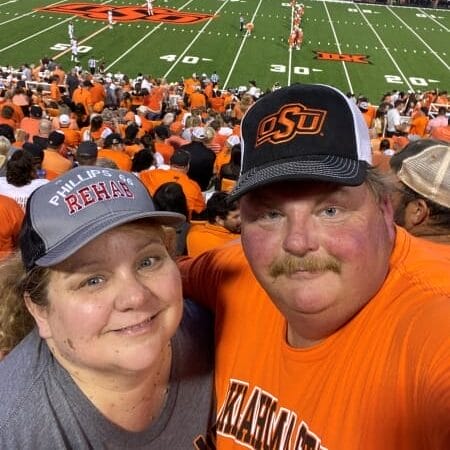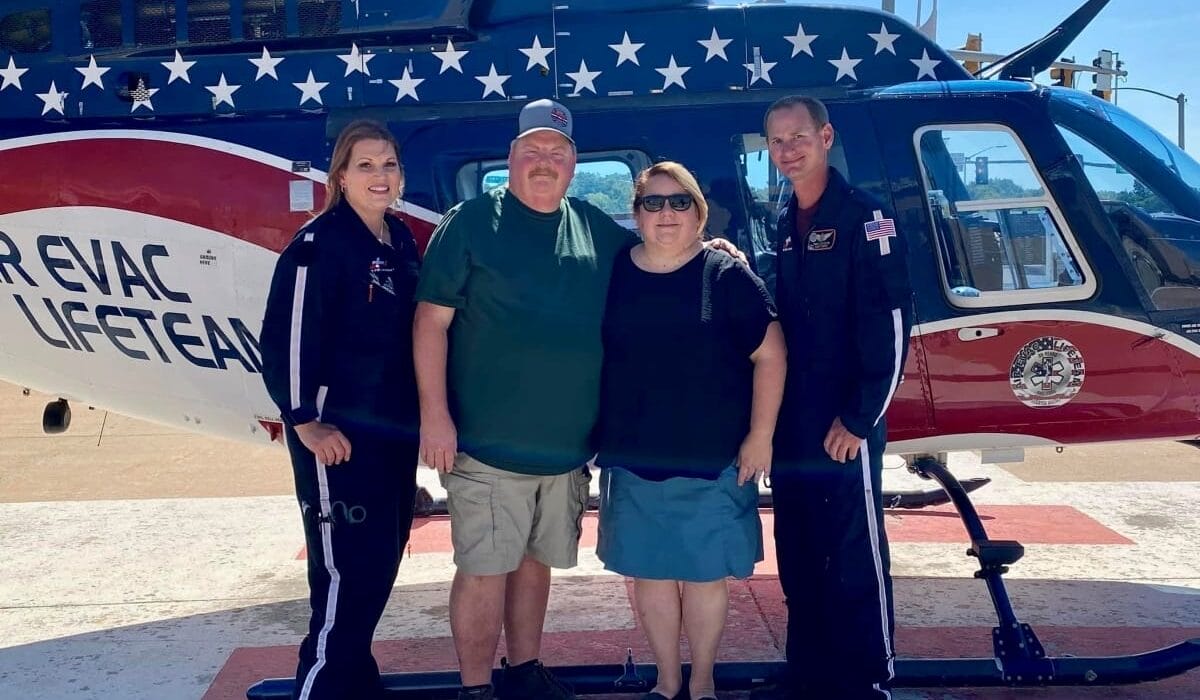Mechanical Engineer Makes Safety Second Nature

Meet Daily Point of Light Award honoree Teri Harris. Read her story, and nominate an outstanding volunteer or family as a Daily Point of Light.
Teri Harris, 56, didn’t always know she would be involved in fire safety. It wasn’t a passion or dream of hers. She also didn’t expect to have cows, but things evolve. Teri moved to Oklahoma after being recruited as a mechanical engineer in college by what would later become Phillips 66. She met her husband, Travis, 14 years ago and now lives on the farm that has been in his family since 1907. Aside from their affection for cows, the couple loves dogs and has fostered 45 or 50 over the years. In fact, their senior dog, Buster, stole their hearts and became a “foster fail.”
Travis has been a volunteer firefighter for nearly 37 years, fire chief for 18. His dedication led to Teri’s own volunteering, starting with completing Ponca City’s Citizens’ Fire Academy before joining the Fire and Life Safety Council. There, she promotes fire prevention and safety and raises money to fund equipment for fire departments with limited resources.
Her interest in the arts has led to years of commitment to the town’s Arts and Humanities Council where she only recently finished her term on the board. This hobbyist photographer and quilter cites the desire to use her right brain for downtime creative pursuits to balance her left-brained job. At that job, she serves on the Volunteer Emergency Response Team where yearly CPR training saved her husband’s life.
What inspires you to volunteer?
When I started to get interested in the arts, I was a single mom, and my kid was going into high school. I knew some friends who volunteered, and I kind of fell into it by accident. They needed some assistance on a production, and I enjoyed meeting new people and being creative. I’ve been blessed, and as a Christian, I believe it’s my responsibility to take the gifts I’ve been given and help other people.

Tell us about your volunteer role with the Fire and Life Safety Council and the Kildare Volunteer Fire Department.
I served as Board Secretary for several years and am currently the Board Vice President for the Fire and Life Safety Council. I’ve also chaired our annual fundraiser for the past few years. I’m responsible for coordination of advertising, ticket sales, sponsorships, etc. We engage three teams of firefighters to grill steak, and our guests try some from each and vote for the best with their cash. It’s great food and an opportunity for the community and the firefighters to get together. We do an auction, too.
It costs around $3,500 to buy a whole set of gear for a firefighter. That’s one of the things that we can fund. Some of our bigger investments recently were three automated CPR devices for ambulances and $75,000 towards the local technology center’s construction of an emergency responder training facility. And we’ve partnered with them to fund auto extrication tools and a simulated mannequin that runs off an iPad to train EMTs.
Our car seat safety check event provides car seats for free or reduced price and shows people how to install them. We also do fire prevention for the elementary schools. We’re hoping to supply some of our county fire departments with smoke detectors to distribute.
Our county only has around 44,000 people, but we have several fire departments, some with full-time paid firefighters and others with a combination of paid and volunteer. Initially, we focused on Ponca City, but we’ve expanded to the county.
At work, I’ve also been volunteering for the emergency response team for 11 years. I’m thankful, because we train at CPR every year.
What are your long-term plans or goals for the organization?
I’d like to see us be more consistent in CPR training for the Fire and Life Safety Council. Anything we can do to educate people on not just CPR but with car seat safety checks and beyond is a success for us.
You had to use CPR on your husband. What happened, and how is it using your training in an emergency vs. a classroom?
My husband experienced sudden cardiac arrest in bed, at 4:30am one morning. I happened to be awake and hit my phone to see what time it was before he started making sounds I’d never heard before. It was pure panic when I realized he was unresponsive. I couldn’t even remember how to unlock my phone.
Once I called 911, it was very matter of fact. It was like, “I have an unresponsive male and he’s this old, and this is where we live,” because our community ambulances don’t all run a paramedic. It’s stuff that I knew from being involved with Travis and the fire service. So, if they know they need a paramedic, they will send one in addition to the ambulance.
Then it was muscle memory. I dragged him to the floor, because you need to be on a hard, flat surface. I started chest compressions. He was getting some oxygen, so I never actually did rescue breathing. It felt like it took forever, but I saw the lights down the road 12 minutes after my call.
He’s one of the 6 or 7% of cardiac arrest patients with no long-term effects. That’s proof that the sooner you start CPR, the better chance of survival that person has.

What have you learned through your experiences as a volunteer?
I admire their dedication. My husband’s been doing this a long time, and I knew what I was getting into when we got married. But there are times when it’s like, I’m really glad we took two cars, because I would have been left behind.
What do you want people to learn from your story?
If you haven’t had CPR, go get it. I would have been a widow if I hadn’t known what to do in that moment. For every minute that CPR isn’t initiated, a person’s chance of survival drops 10%. It was 12 minutes before help got here. Travis didn’t have 120% to give. Even if you’ve had CPR classes, do it again. Just because you did it 20 years ago, it doesn’t mean you would know what to do today. You never know whose life you’re going to save.
Do you want to make a difference in your community like Teri? Find local volunteer opportunities.
